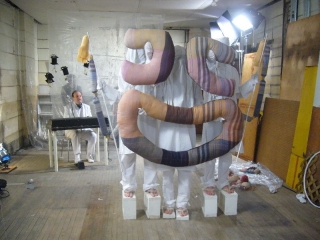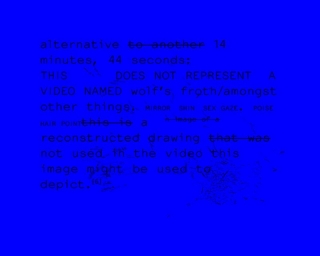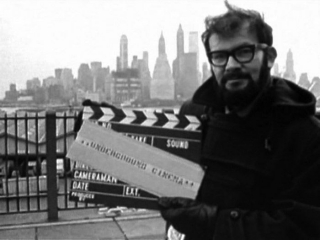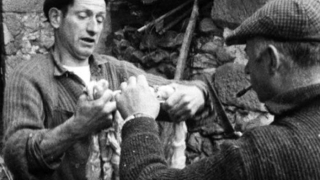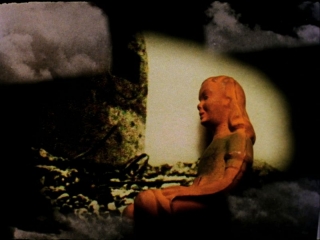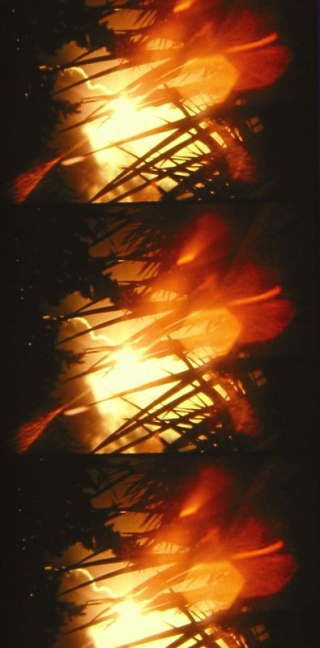Date: 25 October 2009 | Season: London Film Festival 2009 | Tags: London Film Festival
THE EXCEPTION AND THE RULE
Sunday 25 October 2009, at 2pm
London BFI Southbank NFT3
Akosua Adoma Owusu, Me Broni Ba (My White Baby), USA-Ghana, 2008, 22 min
Driven by the pulsing sounds of Afrobeat and American soul, this spirited study of Ghanaian hair salons questions representations of beauty and ethnicity. While teams of women weave elaborate styles, children practice braiding on the blonde hair of white baby dolls, surplus stock exported from the West.
Laida Lertxundi, My Tears Are Dry, USA-Spain, 2009, 4 min
A song of heartache, an afternoon’s repose and the eternal promise of the blue California sky.
Karen Mirza, Brad Butler, The Exception and the Rule, UK-Pakistan-India, 2009, 38 min
Shot primarily in Karachi, The Exception and the Rule employs a variety of strategies in negotiating consciously political themes. Avoiding traditional documentary modes, the film frames everyday activities within a period of civil unrest, incorporating performances to camera, public interventions and observation. This complex work supplements Mirza/Butler’s Artangel project ‘The Museum of Non Participation’.
PROGRAMME NOTES
THE EXCEPTION AND THE RULE
Sunday 25 October 2009, at 2pm
London BFI Southbank NFT3
ME BRONI BA (MY WHITE BABY)
Akosua Adoma Owusu, USA-Ghana, 2008, video, colour, sound, 22 min
From weaves to Jehri curls and dreads, the politics behind hairstyling comes from the roots of self-identification. I am always interested in representations of beauty. I wanted to use the specifics of hair as a metaphor for personal identity, culture, and language. I was also interested in showing the creativity of African women and how this creativity is applied to the body. Me Broni Ba was inspired by an event my older sister experienced when she immigrated to the States. My father told me she touched the hair of white children in her elementary class. The bold touch of the hair is what always stuck with me. Like my sister, I find it difficult to integrate successfully into both Ghanaian and American cultures, and it is often manifested in the way I style my hair. The text in the film came from an excerpt of her childhood journal, the film sort of stemmed from this. (Akosua Adoma Owusu)
MY TEARS ARE DRY
Laida Lertxundi, USA-Spain, 2009, 16mm, colour, sound, 4 min
A film in the three parts of a dialectic. Hoagy Land’s song is played and interrupted by guitar sounds, two women, a bed, an armchair, and the beautiful outside. The lyrics of the song reference the eternal sunshine of California and its promises. (Laida Lertxundi)
THE EXCEPTION AND THE RULE
Karen Mirza & Brad Butler, UK-Pakistan-India, 2009, video, colour, sound, 38 min
The Exception and the Rule, a film shot in Karachi as part of the Museum of Non Participation project, references problematic aspects of the ethnographic documentary film. How might one make a film about a foreign culture and thereby get away from one’s own inscribed images of that culture? Furthermore, is it possible to make such a film and thereby include the perspectives of those being filmed? And, finally, which film genre is able to deal with this kind of theoretical issue? The result is an extremely idiosyncratic hybrid composed of various genres that do not permeate one another but are presented consecutively, in such a manner as to be cited as methods. Genres such as the classic ethnographic film pop up along with the experimental genres of first person documentary, conceptual film and the fake. If the Museum of Non Participation is a non-museum, The Exception and the Rule is a non-documentary film. One learns as little about a foreign culture via the media as one learns about the vital artistic moment (symbolized in myth by the muses) via a museum. The film entwines images of the Other in a complex interweave of medial references and formal refractions; it insists on the moment of non-communicable experience – and thus exacts from the viewer the direct, ‘uncomfortable’ encounter with the real Other. (Marcel Schwierin)
www.mirza-butler.net
Back to top
Date: 25 October 2009 | Season: London Film Festival 2009 | Tags: London Film Festival
FILM IST. A GIRL & A GUN
Sunday 25 October 2009, at 4pm
London BFI Southbank NFT3
Gustav Deutsch, FILM IST. a girl & a gun, Austria, 2009, 97 min
Taking its cue from DW Griffith via J-L Godard, the latest instalment of the FILM IST series is a five-act drama in which reclaimed footage is interwoven with aphorisms from ancient Greek philosophy. Beginning with the birth of the universe, it develops into a meditation on the timeless themes of sex and death, exploring creation, desire and destruction by appropriating scenes from narrative features, war reportage, nature studies and pornography. The Earth takes shape from molten lava, and man and woman embark upon their erotic quest. For this mesmerising epic, Deutsch applies techniques of montage, sound and colour to resources drawn from both conventional film archives and specialist collections such as the Kinsey Institute and Imperial War Museum. Excavating cinema history to tease new meanings from diverse and forgotten film material, he proposes new perspectives on the cycle of humanity. The film’s integral score by long-term collaborators Christian Fennesz, Burkhardt Stangl and Martin Siewert incorporates music by David Grubbs, Soap&Skin and others.
Also Screening: Thursday 29 October 2009, at 4pm, NFT2
PROGRAMME NOTES
FILM IST. A GIRL & A GUN
Sunday 25 October 2009, at 4pm
London BFI Southbank NFT3
FILM IST. A GIRL & A GUN
Gustav Deutsch, Austria, 2009, 35mm, colour, sound, 97 min
During the opening sequence of Gustav Deutsch’s FILM IST. a girl & a gun, a film that received its North American premiere at the 2009 Tribeca Film Festival, we see violet-tinted footage of the real-life cowgirl and sharpshooter Annie Oakley demonstrating her prowess with a gun. After the opening title cards, the film opens with deep red moving images that evoke the creation of the world – shooting flames, circles of fire, smouldering lava, a large-breasted woman, bubbling ooze. Many sequences made with found footage would follow – most all from the silent cinema, but remade, tinted, and ordered in bravura of original filmmaking. Taking off from D.W. Griffith’s quote that all a film requires is a girl and a gun, Episode 13 of Deutsch’s larger project, FILM IST, grows into an elemental exploration of Eros and Thanatos, sex and death.
In 1995, as many were celebrating the 100th anniversary of the birth of cinema, Austrian filmmaker Gustav Deutsch began his multi-year project on the meaning of cinema, sketching out a list of quotes about the art form. Soon, the project became a meditation on the meaning of cinema itself, one that the filmmaker likens to a naturally occurring phenomenon. Like the camera obscura this architect-trained artist has built near his house in Greece, its foundations resting on a concrete foundation of a World War II era German battery, the cinema can serve as a place to contemplate a spectacle of wonders and to ponder universal themes.
FILM IST. a girl & a gun follows the structure of a five act Greek drama, using classical texts by
Sappho, Hesiod and Platon. ‘I wasn’t sure I would start with Genesis,’ the filmmaker explained to me while visiting New York for the Tribeca premiere, ‘but in the archives were these amazing volcanoes in Indonesia … exceptional footage.’ He continued, ‘I wanted to talk about the creation of the universe from the eyes of the goddess of creation, and then destruction. There’s no creation without destruction.’
After seeing images in the Imperial War Museum from the First World War, Deutsch explained, ‘It was amazing to see how millions of men were fighting in a kind of …’ and here he inserts a word from German that means self-forgetting and self-annihilation ‘… that would never have been understandable. What belief system makes them act like this? I don’t accept it. Human beings don’t learn. Therefore, film is ‘missionary’.’
Found footage filmmaking has its roots in experimental and avant-garde traditions. Joseph Cornell is often considered an important early pioneer of the art, Bruce Conner the king during his lifetime, and now Deutsch is considered the living master of this genre. His films are not just edited compilations of clips; rather, the elements become the artistic material in a painstakingly thought-out original artistic work. Much of the source images are orphan films, works that have been previously overlooked or neglected but are culturally significant. He seeks a range of materials, from science and education films to melodramas and slapstick comedies.
Four years in production, the first phase of FILM IST. a girl & a gun was to find material within the archives and to work on the 90-page script. ‘I wanted to choose long excerpts,’ he said, ‘because I thought it was very important to get into the mood and sense it. To be shocked, aroused, to talk about it.’ He started with list of ideas, sending ‘keywords’ to people in the archives. As with any filmmaker, another phase involved convincing the financial supporters to back the work.
He worked with ten archives in Europe, including a rich source in the Netherlands Filmmuseum, but he also wanted to draw upon material from the Kinsey Institute at Indiana University in Bloomington, the source of footage for explorations into sexuality. Because of the Institute’s mandates that the material must follow the strict guidelines of the founder, including serving the purpose of science, it took Deutsch a year to convince them that his use of footage would be appropriate. Arriving in Indiana, he looked through 120 films and selected 42 for viewing, but one-fifth of them were not suitable for playing on an editing table. He helped preserve some of the fragile material for use by the archive by transferring them to other formats.
Together with his long-time partner, artist Hanna Schimek, he estimates that he viewed a total of over 2,500 films in multiple archives, some features and many short subjects, all the while taking notes and sketches. Paring down the potentially useful material to twenty-five hours of footage, he scanned and digitized the clips for his film library. Rendering the clips to black and white, Deutsch applied a range of twelve colours to the appropriate clips, each standing for different emotions. The colours also adhere to traditions in the aesthetics of silent film. He looks for images that can provide a ‘gateway’, as he calls them, to lead from one idea to the next. Each captured frame is 1.8 to 2MB, with notes to identify them. After editing for a year, they went to the archives to order films for scanning and another process of editing. He worked in a similar way with the composers for the original score. After ordering the sequence, the work was then blown up to a 35mm print.
One important theme of the work, Deutsch stressed to me in our conversation, was the search within relationships between males and females ‘for the other half’. ‘For example’, he said, ‘I can shift my behaviour from male to female. The female part is not valued enough. We need to encourage all of us to work with the female side. The limitations of the existing material within the early era of cinema restricted my ability to visually show more of the female point of view.’ In addition, he chose not to use images from the contemporary era, he explained, because most of the issues involving sex and warfare were already established with the first sexual revolution and the First World War. Like a girl and a gun, creation and destruction had already found their way into the spaces of the earliest cinema.
(Teri Tynes)
Back to top
Date: 25 October 2009 | Season: London Film Festival 2009 | Tags: London Film Festival
WHIRL OF CONFUSION
Sunday 25 October 2009, at 7pm
London BFI Southbank NFT3
Mary Helena Clark, And the Sun Flowers, USA, 2008, 5 min
‘Notes from the distant future and forgotten past. An ethereal flower and disembodied voice guide you through the spaces in between.’ (Mary Helena Clark)
Greg Pope, Shot Film, UK-Norway, 2009, 4 min
Taking the expression ‘to shoot a film’ at face value, this 35mm reel has been blasted with a shotgun.
Matthias Müller, Christoph Giradet, Contre-Jour, Germany, 2009, 11 min
My Eyes! My Eyes! Flickering out from the screen and direct to your retina, Contre-jour is not for the optic neurotic. Take a deep breath and try to relax as Müller and Girardet conduct their examination.
David Gatten, Film for Invisible Ink Case No. 142: Abbreviation for Dead Winter (Diminished by 1,794), USA, 2008, 13 min
‘A single piece of paper, a second stab at suture, a story three times over, a frame for every mile. Words by Charles Darwin.’ (David Gatten)
Paul Abbott, Wolf’s Froth / Amongst Other Things, UK, 2009, 15 min
By chance or circumstance, wolf’s froth’s covert syntax refuses to be unpicked. Entangling anxious domesticity with the spectre of aggression, it conjures a mood of underlying discomfort and intrigue.
Lewis Klahr, False Aging, USA, 2008, 15 min
Klahr’s surreal collage journeys through lost horizons of comic book Americana and is brought back down to earth by Drella’s dream. And nobody called, and nobody came.
Oliver Husain, Mount Shasta, Canada, 2008, 8 min
What is ostensibly a proposal for a film script is acted out, without artifice, in a bare loft space as Mantler plays a plaintive lament. A puppet show like none other that will leave you bemused, befuddled and bewildered.
PROGRAMME NOTES
WHIRL OF CONFUSION
Sunday 25 October 2009, at 7pm
London BFI Southbank NFT3
AND THE SUN FLOWERS
Mary Helena Clark, USA, 2008, video, colour, sound, 5 min
Henry James had his figure in the carpet; Da Vinci found faces on the wall.
Within this Baltimore wallpaper: a floral forest of hidden depth and concealment, the hues and fragrance of another era. Surface decoration holds permeable planes, inner passages. There emerges a hypnotic empyrean flower, a solar fossil, a speaking anemone, of paper, of human muscle, of unknown origin, delivering an unreasonable message of rare tranquillity. (Mark McElhatten)
SHOT FILM
Greg Pope, UK-Norway, 2009, 35mm, colour, sound, 4 min
A shotgun is aimed onto filmstrips. Images and sound are created through the destructive force and spread of the shot. Images as wound – entry and exit points. A pattern sliced and spliced, a single instant re-presented and duplicated through time. A literal interpretation unmasks the implied violence embedded in a common phrase ‘to shoot a film’. (Greg Pope)
CONTRE-JOUR
Matthias Müller & Christoph Giradet, Germany, 2009, 35mm, colour, sound, 11 min
The look with which we comprehend the world and which it casts back at us in response breaks up in Contre-jour into disquieting fragments. Blurs, flashes and stroboscope montages disintegrate reality into shadowy images that inflict pain on the eye. A spotlight precisely cuts the individual out of the darkness.
‘I wish you could see what I see’ remains a futile hope. Blind spots gape between self-perception and the perception of others. (Kristina Tieke)
FILM FOR INVISIBLE INK CASE NO. 142: ABBREVIATION FOR DEAD WINTER (DIMINISHED BY 1,794)
David Gatten, USA, 2008, 16mm, b/w, sound, 13 min
Gatten’s Film takes up Darwin to nearly fossilize his words and attempt minute rediscovery in a paper’s inky fibres. Constantly turning the focus (so it seems), Gatten lets these gossamer ink-strands ripple into view out of total blankness (an empty world), more and more, so that even when they are in focus, they’re still just an abstraction: a bunch of fibres entwined. And even, then, of course, there’s the feeling that if Gatten keeps refocusing he’ll discover entirely new strands as well; appropriate to a film whose words are from Darwin, Film feels like an archaeological dig. (David Phelps)
www.davidgattenfilm.com
WOLF’S FROTH / AMONGST OTHER THINGS
Paul Abbott, UK, 2009, video, colour, sound, 15 min
FALSE AGING
Lewis Klahr, USA, 2008, video, colour, sound, 15 min
It’s hard to believe that False Aging clocks in at under 15 minutes, given how powerfully it evokes passing decades punctuated by muffled eruptions of longing and regret. A button revolves around a clock – and the world moves with it. Klahr shares Joseph Cornell’s alchemical genius, but his collaged reveries cast deeper shadows and offer little magical protection from death and disappointment. The soundtrack draws on The Valley of the Dolls, Jefferson Airplane, and Lou Reed & John Cale’s ‘Songs for Drella’.
‘As Cale channels Warhol, recounting a nightmare involving a snowy park under the stairs and anxieties about troubles real and imagined, a blond man peers at cityscapes, a skeletal hand snatches a fortune, and no-longer-redeemable trading stamps flutter by.’ (Kristin M. Jones)
MOUNT SHASTA
Oliver Husain, Canada, 2008, 16mm, colour, sound, 8 min
Pastel-coloured institutional walls contain fabric-and-pipe-cleaner inventions of a whimsy that almost seems forced, were it not for the total belief evinced by those participating in it. In the background, a man at a cheap keyboard (again, of the sort familiar from middle-school music rooms of a certain era) warbles a story-song as half-formed handkerchief puppets fly around each other on visible wires, the puppeteers made ‘invisible’ by their white canvas beekeeper suits. Husain’s story is about a mountain trip waylaid by a fog which turns out to be the smoke from a destructive fire. In a sense, this could be a way of understanding Mount Shasta as a film. The elements that envelop this gorgeous film in mystery (is this avant-garde? a narrative short?
a children’s film?) are also the ones that threaten to unmake it at every turn, since ‘the spell’ is always already about our ability to turn away from its blatant disenchantment. (Michael Sickinski)
www.husain.de
Back to top
Date: 24 November 2009 | Season: Miscellaneous
WE DIG REPETITION: PETER ROEHR
Tuesday 24 November 2009, at 7:30pm
New York Light Industry
“I alter material by organizing it unchanged. Each work is an organized area of unchanged elements. Neither successive or additive, there is no result or sum.” (Peter Roehr, 1964)
You might think that Andy Warhol took pleasure in endless repetition, but he’s got nothing on Peter Roehr, a German artist whose brief career produced hundreds of works using type, photography, collage, film and audiotape. Not content with applying mechanical reproduction techniques to art-making, Roehr instead chose to appropriate industrially produced materials. His many photo collages present austere grids of identically cropped images from magazines. Similarly, his film and sound montages are constructed from brief passages, frequently drawn from commercial advertising, repeated without variation, for an irregular number of reiterations. The result is an insistent, hypnotic demonstration of stoic seriality that takes time and time again.
Peter Roehr, Film-Montagen I-III, 1965, 16mm film, 23 minutes
Peter Roehr, Ton-Montagen I-II, 1965, audiotape, 60 minutes
Roehr died at the age of 23 in 1968. From November 2009 to March 2010, his work is surveyed in parallel exhibitions at the Städel Museum and Museum für Moderne Kunst in Frankfurt which commemorate the 60th anniversary since his birth.
“I feel identical with what I do. In the ‘montages’ I realize, in an unrestricted manner, everything that is important to me. I believe, I am free.” (Peter Roehr, 1965)
Introduction by Mark Webber. Screening repeated Friday 9 July 2010 at Artists Space, New York.
Date: 6 December 2009 | Season: Miscellaneous
UNDERGROUND NEW YORK
Sunday 6 December 2009, at 7:30pm
New York Gershwin Hotel
In the 1960s, filmmakers investigated new forms of production in dialogue with radical shifts in art, music, performance and popular culture. Following the example of the Beats, the counterculture was alive with protest, freedom of expression and the breaking of taboos, and from the Film-Makers’ Coop to Andy Warhol’s Factory, portable 16mm cameras were bringing a whole new way of seeing to the cinema screen. These heady days of “underground film” were captured by Gideon Bachmann in a spirited broadcast for German television. Rarely seen today, it is one of the few surviving documents to show aspects of New York’s independent film culture during this exhilarating period.
UNDERGROUND NEW YORK (PROTEST WOFÜR)
Gideon Bachmann, 1967, black & white, sound, 51 minutes
Shirley Clarke grows carrots on top of the Chelsea Hotel and meets Jonas Mekas and Michelangelo Antonioni at the Film-Makers’ Distribution Center. Allen Ginsberg, Susan Sontag and Tuli Kupferberg protest for peace and are apparently shipped off to the Department of Correction. USCO freak out in their intermedia church and Maurice Amar stages a happening at the Movie Subscription Group. Gideon Bachmann goes on location with Adolfas Mekas in New Jersey, George Kuchar in the Bronx, and Carl Linder in his bedroom. Bruce Conner dances in a diner, and Andy Warhol fakes it for television.
Presented by Mark Webber, the Gershwin’s outgoing artist in residence, who is currently researching an oral history of avant-garde cinema from the 1950s through the 1970s. Some of those interviewed for the project will be present.
Date: 23 September 2010 | Season: Miscellaneous | Tags: 25fps
FOOD: TWO APPROACHES
Thursday 23 September 2009, at 4pm
Zagreb 25FPS Festival
The two films in this programme depict two very different styles of food preparation, each of which is specific to its environment. Though formally quite similar, the circumstances of their making are distinctly varied. Food follows a day in the life of a communal restaurant in New York’s downtown art scene, whereas Le Cochon records the traditional slaughter of a pig in a remote French village. Both date from the early 1970s but while Matta-Clark’s film could almost be a contemporary report from any cosmopolitan city, Le Cochon documents a phenomenon of rural life that can rarely be experienced by outsiders.
Jean Eustache & Jean-Pierre Barjol, Le Cochon (The Pig), France, 1970, 50 min
Gordon Matta-Clark, Food, USA, 1973, 47 min
Curated by Mark Webber for 25FPS.
PROGRAMME NOTES
FOOD: TWO APPROACHES
Thursday 23 September 2009, at 4pm
Zagreb 25FPS Festival
LE COCHON (THE PIG)
Jean Eustache & Jean-Pierre Barjol, France, 1970, 35mm, b/w, sound, 50 min
The pig’s life on screen is short lived – she is quickly despatched by a swift cut of the throat, but then it takes five men the best part of a day to prepare the meat. Most of them smoke constantly throughout the process, which is undertaken with an air of calm assuredness. There appears to be an economy in their artisanal activity – each has his role, and they’ve been doing it this way all their lives, as have their ancestors before them. The butchering takes place on a bed of straw in the yard. Nothing is wasted. The head is removed, and the blood and intestines are saved for traditional delicacies, the rest cut into joints. Inside the house, two men clean the intestines on the kitchen table before they are cut into equal lengths and used for sausages. It snows. Bread is delivered. In the evening everyone celebrates with wine and song. The farmers talk to each other as they go about their business but no subtitled prints are known to exist. According to co-producer Luc Moullet, their dialect is so strong and parochial that much of what they say is intelligible to native French speakers.
Jean Eustache’s distinctive and uncompromising films are either documentary or semi-biographical fictions, frequently pertaining to aspects of provincial life. Often associated with the French New Wave, he made only two features, of which Le Maman et la Putain is the most well-known. He was born and raised in Pessac in the suburbs of Bordeaux in 1938, and committed suicide in 1981 after sustaining serious injuries in a car crash.
FOOD
Gordon Matta-Clark, USA, 1973, 16mm, b/w, sound, 47 min
Matta-Clark’s film situates the process of food preparation in New York’s Soho at the beginning of the area’s gentrification. In the early 1970s, factory units in this former industrial zone were reappropriated as live/work lofts and art spaces in a process of inner city renewal which has since been repeated in many urban centres. Food is again at the centre of social exchange – this time in the form of a collective restaurant that served up home style cooking to all-comers but essentially functioned as a hub for a growing network of artists. Caroline Goodden was the owner and de-facto manager; Gordon Matta-Clark designed the space which occupied a corner storefront. His innovative (though not necessarily practical) design provided a central ‘stage’ for cooking and preparation, one of New York’s first open kitchens. Its roster of chefs was drawn from artist groups such as the Trisha Brown and Grand Union dance companies, the Phillip Glass Ensemble and Mabou Mines theatre troupe. On Sundays, guest chefs including Yvonne Rainer, Robert Rauschenberg, Keith Sonnier and Donald Judd cooked their specialities. Over 100 people worked in the restaurant during the first six months. The film begins early morning at the fish market. Back at the restaurant, fish and duck gumbo is prepared and dairy products are delivered. During evening service, simple meals of salads or sea bass and cucumber are served as an accordionist entertains. After closing, the place is cleaned and bread is prepared for the following day. The camera floats freely through the action, stopping occasionally for comments from customers. Photographer Robert Frank was responsible for much of the filming and can occasionally be seen holding the microphone.
Gordon Matta-Clark made approximately 20 films, most of which document his performances or architectural interventions. He was born in New York in 1943 and died in 1978. In the decades since his death, he has been increasingly acclaimed as a key figure whose work presages many aspects of contemporary art practice.
Back to top
Date: 23 October 2010 | Season: London Film Festival 2010 | Tags: London Film Festival
THE BFI 54TH LONDON FILM FESTIVAL
23—24 October 2010
London BFI Southbank
The EXPERIMENTA WEEKEND is a rare opportunity to experience artist’s film and video within the concentrated space of the cinema. This annual survey brings together works that acknowledge a tradition of avant-garde filmmaking while taking us forward into the expanded field of contemporary moving image.
Victor Alimpiev, Thom Andersen, Martin Arnold, Daniel Barrow, Neil Beloufa, Duncan Campbell, Thomas Comerford, Nathaniel Dorsky, Erin Espelie, David Gatten, Janie Geiser, Inger Lise Hansen, Lawrence Jordan, Richard Kerr, Lewis Klahr, Alexi Manis, Rebecca Meyers, Miranda Pennell, Samantha Rebello, Emily Richardson, Ben Rivers & Paul Harnden, John Smith, Phil Solomon, Peter Tscherkassky, Timoleon Wilkins.
Eight curated programmes demonstrate the breadth and diversity of short-form practice and include works by Nathaniel Dorsky, Miranda Pennell, Ben Rivers, Peter Tscherkassky. Featured artist Lewis Klahr will introduce his evocative cut-out animations and Daniel Barrow performs live. Two installations by Emily Richardson and Martin Arnold, each memorialising very different cinematic institutions, will be shown continuously for one day each. An additional event at the Natural History Museum explores the legacy of Darwin and the Galapagos through a new film by David Gatten.
The EXPERIMENTA WEEKEND is curated by Mark Webber, with assistance from Melissa Gronlund.
Due to the popularity of the Experimenta Weekend over the past few years, we are introducing repeat screenings. Rather perversely, some of these additional screenings will take place before the weekend. Outside the weekend programme, the Festival’s Experimenta strand also includes features by John Akomfrah, James Benning, John Gianvito, Li Hongqui, Sharon Lockhart, and Ben Russell.
Date: 23 October 2010 | Season: London Film Festival 2010 | Tags: London Film Festival
THE FUTURIST
Saturday 23 October 2010, from 12-7pm
London BFI Southbank Studio
Illuminated by the light of the projector, the interior of a large, 1920s picture house is documented from a central position in the stalls. Emily Richardson’s films record impressions of environments ranging from natural landscapes to industrial or urban spaces. The Futurist is the first of a series in homage to the cinema experience.
THE FUTURIST
Emily Richardson, UK, 2010, video, colour, sound, 4 min (continuous loop)
The Futurist Cinema, Scarborough, is threatened with closure. This 2000 seat cinema and theatre is a pre-digital relic that needs to be recorded before it is potentially erased from memory. As independent cinemas struggle to find funding to make the switch from 35mm to digital projection systems I felt I wanted to make a series of films in homage to film and the cinema experience. The Futurist is a condensed experience of film viewing, a single 360 degree animated shot of a feature film projection in an empty 1920s cinema, where the sound becomes a cacophony of past projections and the aural experience is closer to that of the projectionist than the audience. (Emily Richardson)
Co-commissioned by Lumen and imove, Yorkshire’s Legacy Trust programme. Funded by Legacy Trust UK, Arts Council and Yorkshire Forward. With thanks to Andrew Nesbit and Colin Bainbridge, The Futurist, Scarborough.
Emily Richardson’s films explore landscapes and environments to reveal the way that activity, movement and light is inscribed in place. They focus the mind and eye to detail, finding transcendence and emotion in the everyday. ‘Time Frames’, a book on her work, is published by Stour Valley Arts, and a DVD featuring six of her films is available from LUX.
Date: 23 October 2010 | Season: London Film Festival 2010 | Tags: London Film Festival
READING BETWEEN THE LINES
Saturday 23 October 2010, at 2pm
London BFI Southbank NFT3
Thomas Comerford, The Indian Boundary Line, USA, 2010, 42 min
Comerford’s essay maps a historical demarcation which originally divided Native American land from that which was ceded to white settlers in 1812. Modern life has obscured the traces of this history in the Rogers Park district of Chicago. Juxtaposing past with present, footage shot along this formerly disputed territory is matched with readings from official documents, fiction and quotidian accounts.
John Smith, Flag Mountain, UK, 2010, 8 min
A view across the city of Nicosia, over the Green Line border, to an unusual spectacle on a hillside. Lives continue in its shadow, amongst the contrasting flags, anthems and calls to prayer.
Miranda Pennell, Why Colonel Bunny Was Killed, UK, 2010, 27 min
An exploration of turn of the century colonial life along the Durand Line, the frontier between Afghanistan and British India (now Pakistan). Remarkable period photographs are closely analysed as we listen to reports of exchanges between westerners, natives and mullahs written by missionary doctor TL Pennell.
Also Screening: Monday 25 October 2010, at 2pm, NFT3
PROGRAMME NOTES
READING BETWEEN THE LINES
Saturday 23 October 2010, at 2pm
London BFI Southbank NFT3
THE INDIAN BOUNDARY LINE
Thomas Comerford, USA, 2010, video, colour, sound, 42 min
Over the last eight years, Chicago musician and filmmaker Thomas Comerford has been at work on a series of quietly-observed films that contemplate the entwined social, political, and environmental histories of Chicago (Figures in the Landscape, 2002; Land Marked / Marquette, 2005). The Indian Boundary Line follows a road in Chicago, Rogers Avenue, that traces the 1816 Treaty of St. Louis boundary between the United States and ‘Indian Territory’. In doing so, it examines the collision between the vernacular landscape, with its storefronts, short-cut footpaths and picnic tables, and the symbolic one, replete with historical markers, statues, and fences. Through its observations and audio-visual juxtapositions, The Indian Boundary Line meditates on a span of land in Chicago about 12 miles long, but suggests how this land and its history are an index for the shifting inhabitants, relationships, boundaries and ideas of landscape – as well as the consequences – which have accompanied the transformation of the New World.
www.thomascomerford.net
FLAG MOUNTAIN
John Smith, UK, 2010, video, colour, sound, 8 min
In Nicosia, the divided capital of Cyprus, a display of nationalism is taken to its logical conclusion. Moving between macro and micro perspectives, Flag Mountain sets dramatic spectacle against everyday life as the inhabitants of both sides of the city go about their daily business. (John Smith)
www.johnsmithfilms.com
WHY COLONEL BUNNY WAS KILLED
Miranda Pennell, UK, 2010, video, b/w, sound, 27 min
Triggered by the writings of a medical missionary on the Afghan borderlands, a distant relative of the filmmaker, the film is constructed from still photographs of colonial life on the North West frontier of British India at the turn of the 20th century. Searching for clues to the realities behind images framed during a time of colonial conflict, the film plays sound against image to find contemporary parallels in Western portrayals of a distant place and people. (Miranda Pennell)
www.mirandapennell.com
Back to top
Date: 23 October 2010 | Season: London Film Festival 2010 | Tags: London Film Festival
SUBLIME PASSAGES
Saturday 23 October 2010, at 4pm
London BFI Southbank NFT3
Alexi Manis, Shutter, Canada, 2010, 8 min
Shutter suggests the uncanny atmosphere and changing light on the day of a total eclipse.
Timoleon Wilkins, Drifter, USA, 1996-2010, 24 min
Fragments of the filmmaker’s life, home and travels, recorded over a 14-year period. “The glories of atmospheric light and colour, inward soul-drifting, and the literal sensation of drifting within and through each shot and cut.” (TW)
David Gatten, Shrimp Boat Log, USA, 2010, 6 min
“300 shots, 29 frames each, alternating between a notebook listing the names of shrimp boats that frequent the mouth of the Edisto River and images of these same boats.” (DG)
Rebecca Meyers, Blue Mantle, USA, 2010, 35 min
Blending 19th century American literature with factual accounts, illustrations and music by Debussy and Wagner, this oblique portrait of a shipwrecked coastline conveys the vastness and majesty of the ocean. A song to the sea, and a commemoration of those who have risked their lives off the treacherous Massachusetts shore.
Inger Lise Hansen, Travelling Fields, Norway, 2009, 9 min
In the third film of her ‘inverted perspective’ trilogy, Hansen turns her camera on the North West Russia, creating monumental and uncanny vistas from these barren wastelands.
Also Screening: Friday 22 October 2010, at 4:15pm, NFT3
PROGRAMME NOTES
SUBLIME PASSAGES
Saturday 23 October 2010, at 4pm
London BFI Southbank NFT3
SHUTTER
Alexi Manis, Canada, 2010, 16mm, colour, sound, 8 min
Shutter tracks the rising sun, the lengthening shadows and the darkening day of a total solar eclipse. Shutter is a formal exploration of the phenomenon of the sun eclipsing objects in the natural world. Inspired by footage of friend and amateur astronomer Andreas Gada’s 16mm recording of the 1980 total solar eclipse, this work captures the beauty, complexity and terror of the shifting light that precedes and accompanies an eclipse. Shadow, focal variance and illumination of earth-bound nature conspire along the course to the incomparable moment of totality. (Alexi Manis)
DRIFTER
Timoleon Wilkins, USA 1996-2010, 16mm, colour, silent, 24 min
Drifter is the title; it’s essentially a collection (memoir) of footage dating back from 1996 to the present. The title, the theme, is drifting; mentally / physically. People who’ve drifted into and out of my life, and the visual themes (clouds, snow, highways, trains, oceans) that (finally) tie all my various Bolex-Kodachrome escapades together. Soft movement across the screen. My own wanderlust is in there as well. (Timoleon Wilkins)
SHRIMP BOAT LOG
David Gatten, USA, 2010, 16mm, b/w & colour, silent, 6 min
Shrimp Boat Log, the first reel of the ongoing Continuous Quantities series, contains 300 shots, 29 frames each, alternating between a notebook listing the names of shrimp boats that frequent the mouth of the Edisto River and images of these same boats. I started keeping track of these boats in 1994 when I first began visiting Seabrook Island, South Carolina, for family vacations. I’ve returned to this spot many times since, making a series of underwater, cameraless films there (the What the Water Said series), and always continuing to watch for the shrimp boats. I filmed these images during the summer and fall of 2006 and cut them – using Leonardo’s Notebooks as guide – over the next several years. (David Gatten)
www.davidgattenfilm.com
BLUE MANTLE
Rebecca Meyers, USA, 2010, 16mm, colour, sound, 35 min
blue mantle was shot along the Massachusetts coast, on Cape Cod and Cape Ann and around the South Shore. Images include paintings by Winslow Homer and illustrations from Harper’s Weekly accounts of disasters and rescues at sea. The main musical sources are Debussy’s ‘La mer’, Wagner’s ‘The Flying Dutchman’ and ‘Lowlands,’ a sea shanty. Texts range from Henry Wadsworth Longfellow to Thoreau to Melville to various other 19th-century (and earlier) writings. The only cinematic representations supplementing my own footage are Edison’s 1900 A Storm at Sea and a model-size Eidophusikon (a pre-cinematic 18th-century theatrical spectacle described in its day as ‘moving pictures, representing phenomena of nature’). The 40 miles of sea between Chatham and Provincetown came to be called an ocean graveyard due to the thousands of wrecks that occurred there during a time when sea-going vessels were the primary means for ‘bringing man nearer unto man’ (Longfellow). Today, among the not-invisible memorials and markers in Gloucester and along the cape of maritime histories, one can also find the remains of The Frances, a ship sunk in a December gale in 1872 and still visible at low tide at a popular Truro beach (most people walking by assume it is some kind of strange rock formation). US Life Saving Service men dragged the boat from the bay across the Cape to the outer beach and rescued all aboard. The captain died several days later from the effects of exposure and is buried in Truro. There are hundreds of stories like this one and many more with much more tragic outcomes. Cape Cod was also the site of two major developments in transatlantic communication: the termination point of ‘le Direct’, a 3200-mile submarine telegraph cable laid between France and Massachusetts in 1869, and the location of the first US wireless transmitting station established by inventor Guglielmo Marconi at the turn of the 20th century. Such historic moments of human progress striving to overcome nature’s vastness stir the imagination. (Rebecca Meyers)
TRAVELLING FIELDS
Inger Lise Hansen, Norway, 2009, 35mm, colour, sound, 9 min
Shot in Northern Russia, Travelling Fields is the third film in Inger Lise Hansen’s inverted perspective trilogy, following Proximity (2006) and Parallax (2009). The films focus on a particular phenomenon occurring through a change of perspective and animated camera movements, as a way of redefining a place and its geography. In these films sections of the landscape are documented by moving the camera one frame at the time, along a track. As each of the earlier films focus on one particular location, Travelling Fields offers a more complex viewing as it moves between different topographies and locations in the Kola Peninsula.
Back to top


